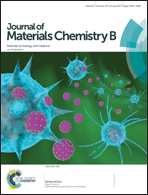Repair of volumetric bone defects with a high strength BMP-loaded-mineralized hydrogel tubular scaffold†
Abstract
Efficient repair of critical-size volumetric bone defects remains a challenge due to the additional complicated surgery required for fixation. In this work, we first synthesized hydrogen bonding crosslinked supramolecular polymer (SP) hydrogels termed as P(NAGA-VPA) by copolymerizing two carefully selected monomers, N-acryloyl glycinamide (hydrogen bonding monomer) and vinylphosphonic acid (mineralization active monomer) directly in a concentrated aqueous solution. The P(NAGA-VPA) hydrogels were then subjected to in situ precipitation mineralization to generate novel high strength mineralized SP hydrogels. The concerted dual physical crosslinkages of NAGA H-bonds and nanocrystal–polymer interaction led to the best comprehensive mechanical performances with a tensile strength of over 1 MPa and a compressive strength of 5 MPa in an equilibrium swelling state. The mineralized SP hydrogel tubular scaffold was fabricated and encapsulated with bone morphogenetic protein-2 (BMP-2). The BMP-2-loaded mineralized SP hydrogel tube was finely sleeved over the murine radial defect without resorting to any additional surgical fixation. The outcome of 8-weeks implantation demonstrated that this hybrid tubular scaffold contributed to an efficient repair of volumetric bone defect by accelerating new bone formation and seamlessly bonding to the bone surface.



 Please wait while we load your content...
Please wait while we load your content...